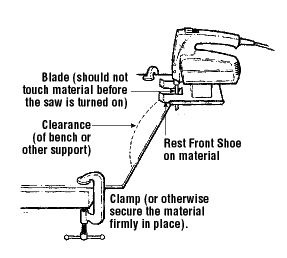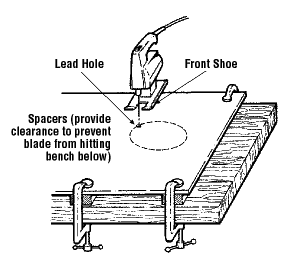Powered Hand Tools - Saws - Sabre, Jig and Reciprocating
On this page
What should you do before starting to cut with powered hand saws?
Back to top- Wear safety glasses or goggles, or a face shield (with safety glasses or goggles).
- Disconnect the power supply before changing or adjusting the blades.
- Use lubricants when cutting metals.
- Keep all cords clear of the cutting area.
- Position the saw beside the material before cutting and avoid entering the cut with a moving blade.
- Make sure guards, if present, are installed and are working properly.
- Inspect the powered hand saw before using it. Do not use a damaged saw (cracks, missing parts, frayed cords, loose fasteners) or a blade with missing teeth.
- Secure the workpiece using clamps or vise to prevent movement.
- Keep the work area clear.
- Make sure there is good lighting in the work area.
- If using a battery-powered hand saw:
- Inspect the battery for any damage, cracks, or leaks before use.
- Follow the manufacturer's instructions for charging and storing the battery. Avoid overcharging or exposing it to extreme temperatures. See Battery Charging - Lithium-ion Batteries for more information.
What should you do to work with powered hand saws safely?
Back to top- Hold the reciprocating saw with both hands for better control.
- Remember, sabre saws cut on the up stroke.
- Secure and support stock as close as possible to the cutting line to reduce vibration.
- Keep the base or shoe of the saw in firm contact with the stock being cut.
- Select the correct blade for the material, and make sure it is clean and sharp. Let the blade do the work; do not force the cut.
- Set the blade to extend no further than 0.32 to 0.64 cm (1/8 to 1/4 inch) beyond the material being cut.
- Wait until the saw reaches its full power before beginning the cut.
- Do not force a saw along or around a curve. Allow the machine to turn with ease.
- Do not insert or withdraw the blade from a cut or lead hole while the blade is moving.
- Do not put down a saw until the motor has stopped.
- Do not reach under or around the stock being cut.
- Maintain control of the saw always.
- Avoid cutting above shoulder height.
- Wear appropriate personal protective equipment (PPE), including safety glasses or goggles, hearing protection, and respiratory protection, if required.
- Know what is behind or beneath the material before cutting, especially for drywall or flooring. Be aware of possible electrical wiring, water pipes, gas lines, or heating/ventilation/air conditioning (HVAC) components that could cause a hazard if struck.
How should you start an external cut?
Back to top- Place the front of the saw's shoe (base plate) firmly on the stock (material).
- Make sure that the blade is not in contact with the material before starting the saw to help prevent kickback or stalling.
- Hold the saw firmly with both hands, keeping it steady and aligned with the cut line.
- Switch the saw on and allow it to reach full speed.
- Slowly feed the blade into the stock, maintaining steady, even forward pressure.

How should you start an inside cut?
Back to top- Drill a lead hole slightly larger than the saw blade.
- With the saw switched off, insert the blade in the hole until the shoe rests firmly on the stock.
- Do not let the blade touch the stock until the saw has been switched on. Hold the saw firmly, switch it on, and allow it ot reach full speed before beginning the cut.
- Guide the saw smoothly along the cut line, using steady and controlled forward pressure.

Refer to Powered Hand Tools - Basic Safety for Electric Tools for general safety tips.
- Fact sheet last revised: 2025-10-15

